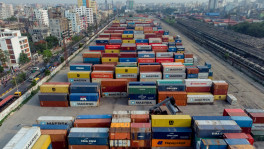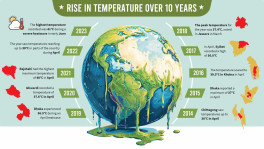An economic tsunami like no other in recent memory
Vaccination will ease a psychological constraint on buying and selling activities that are the fulcrum for production, investment, and employment in any economy

Until the coronavirus appeared a year ago with ever-changing novelties, ideas such as lockdowns, social distancing, masking, flattening the curve and herd immunity were at best scientific curiosities to the layperson. Numbers such as the positivity rate, R-naught and case fatality rates were stuff from hard-to-relate epidemiological theory. These, plus vaccines and virus mutations, now shape our day to day conduct at individual and collective levels in ways inconceivable a year ago.
Monday marks one year of the detection of the first Covid-19 case in Bangladesh.
Life in Bangladesh is increasingly getting closer to the pre-pandemic rhythm with increasing virus fatigue; declines in cases, hospitalisations, deaths; and vaccination rollout. The twilight of the pandemic is in sight but not before upending the life and livelihood systems we were used to. So much of the mobility and assembly we take for granted turned out to be not safe almost overnight. Only time will tell whether this was just a disruption or a hinge.
Covid-19 dented development in rich and poor countries alike. For the first time in over a hundred years, the entire globe shared the same crisis in real time. The contractionary impulse from health propagated through the rest of the global economy faster than the time it took to comprehend the ferocity of the virus. The spread and morbidity effects surprised even virus "prophets" such as Bill Gates and a few notable virologists.
Livelihood disruptions
Since the first official detection on 8 March 2020, case and death counts rose quickly in Bangladesh. The pressure on the national health system in virus hotspots mounted. The cost of medicine and doctors' fees multiplied. The government implemented a national "holiday" from 26 March to 30 May 2020; suspended public transportation; put in place rules on social distancing; and mandated mask wearing. After wavering initially, testing, case follow up and care improved.
The pandemic deepened the pre-existing drags on growth. The supply of intermediate goods from China was disrupted and, as the virus spread abroad, export orders from Europe and the US declined precipitously. Exports shipment decline worsened from 4.8% in the first eight months to 16.8% by the end of FY20. Private investment slowed with growth in imports of capital goods declining from 7.1% in the first eight months to 2.4% by the end of FY20.
Growth receded in manufacturing, construction, transport, retail, hotels, restaurants, banking, and tourism. Resilient in rice, agriculture incurred losses in poultry, meat, and dairy due to supply chain disruptions. Some pushbacks to the systemic economic downturn came from e-commerce, digital services, home deliveries, and production of pharmaceuticals, sanitary products, masks, certain food items (biscuits, spices) and a few consumer durables (washing machines, trimmers).
A rapid assessment survey carried out by Brac and the Power Participation and Research Centre (PPRC) in the first half of April found 71% of informal workers lost jobs, while the income of those who still had work dropped by 50 to 90%. Earnings of almost 80% of the vulnerable non-poor shrank. In the World Bank's (WB) Bangladesh Business Pulse Survey of 500 MSMEs in July 2020, 94% reported a sharp drop in sales, 83% making losses, and 33% unable to service debts. Over 4,80,000 migrants returned from abroad between January and December 2020. Millions of workers returned from cities to villages.
Learning poverty
Learning of millions of students in pre-primary, primary, secondary, tertiary, and technical education came to a halt. Schools at all levels were closed nationwide from 17 March 2020 and are expected to remain so till end-March 2021. Online learning substituted only remotely, leaving out a vast majority.
Bangladesh was grappling with issues of out-of-school children, low and unequal learning outcomes even before the pandemic. The pandemic deepened the learning crisis and exacerbated education divides. It most likely increased the number of out-of-school children due to prolonged disengagement from school and learning activities and disrupted teachers' professional development.
Average quality adjusted years of schooling are estimated (by WB) to fall from 6.5 years to 6.1 years. This could translate to a 3% reduction in annual earnings for the student once they enter the labour market.
Steeper inequality
Covid-19 exacerbated pre-existing conditions of inequality wherever it arrived. Bangladesh was no exception. This is evident from all household surveys and simulations done at various times in the last 12 months. They show that the cliché about the coronavirus treating all the same is extremely misleading.
Jobs and earnings losses caused sharply higher poverty rates in both rural and urban spaces. Hundreds of factories closed because of cancelled orders and mobility restrictions, impacting millions of jobs in RMG, leather, construction, and the service sectors. According to a survey by the Centre for Policy Dialogue (CPD) and Brac University, 3,57,000 jobs were lost in RMG alone in 2020. Many of them live from paycheque to paycheque. Millions engaged in contact intensive services regressed into poverty as their clients sheltered at home.
An April 2020 rapid assessment by the WB found household incomes dropped by 60% in rural areas and 75% among the poor. A large share of the poor and vulnerable, engaged in daily wage or self-employment activities, suffered disproportionately higher income losses in urban areas where employment is concentrated in informal services and garments. Over 70% workers in slums lost jobs. Women in Dhaka and Chittagong experienced relatively higher job losses.
A nationwide survey in November-December by the South Asia Network on Economic Modelling (Sanem) provided credible evidence on the magnitude of the differential impact on the poor, the vulnerable and the non-poor. Relative to their December 2018 benchmark, household expenditure per capita of the extreme poor, moderate poor and vulnerable non-poor declined 45%, 29% and 12% respectively while that of non-poor increased 6%. The declines presumably happened in the pandemic year.
While most people suffered from the health and economic impacts of the pandemic, several millionaires saw their financial wealth gyrate as evident from Bangladesh Bank data on the size distribution of deposits. The economic incidence of the virus was heavier on the weaker.
A new low
How bad was the disruption in livelihood and distributive justice in Low Middle-Income Countries generally? A study published on February 5 in the journal "Science Advances" suggests the economic downturn in LMICs was far worse than the Asian financial crisis of the late 1990s or the Great Recession in 2008-09.
Data collected from over 30,000 households from April to July 2020 found "staggering" income losses after the pandemic emerged, with a median 70% of households across nine countries in Africa, Asia and Latin America reporting financial losses. Fifty to 80% of respondents in Bangladesh, Burkina Faso, Colombia, Ghana, Kenya, Rwanda, and Sierra Leone experienced a drop in income. Even the middle class had to tighten their budget on food and faced unemployment risks. These happened too fast to allow people time to prepare.
Many households were unable to meet basic nutritional needs – 48% of rural Kenyan households missed meals or reduced diet along with 69% in rural Bangladesh and 87% in rural Sierra Leone. Parents pulled children out of school because they could not afford tuition. Many reported delaying health care, including prenatal care and vaccinations. Some communities reported rising levels of domestic violence.
Asymmetric recovery
The Bangladesh economy has recovered from the bottom reached in March-May. Cases detected in February were 48.8% and the number of new deaths 51.6% lower than the previous month. With the dramatic flattening of the case positivity rates and steepening of virus fatigue, activities are swinging back without enough help from the demand side.
All mobility indicators in the Google Community Report on Bangladesh crossed pre-pandemic baseline in recent months. Electricity consumption rose 2.8% in the first quarter of FY21 and 7.6% in the second quarter compared to the same periods of the previous fiscal year. Private consumption is rising as indicated by improved, yet weak, recovery in domestic VAT collections. Exports rebounded, although still below the depressed levels in the corresponding period of FY20. Investments, both public and private, have lagged the most.
Several rapid phone surveys, conducted in the last half of 2020, found substantial improvements in food security and the ability to pay rent, albeit still well below the pre-pandemic benchmarks. The actual output is still, depending on the sectors, 10% to 30% lower than the pre-pandemic benchmarks. Earnings have not recovered fully. Salaried and wage workers report substantial uncertainty about their jobs.
The recovery has not been symmetric for all socio-economic classes. The asymmetries have been adroitly chronicled in CPD's February report on the state of the economy. The underlying factors range from imbalance in market power to the perils of informality. The consequences of the former is harshly evident in garments and that of the latter in the implementation of the stimulus package.
Garment producers cannot bargain much because of their huge number globally. Fashion brands determine how much to pay when for orders and what turnaround time to give to suppliers. Not sure how to forecast going forward, the big brands have been placing orders at much smaller volume and pushing down on price more than they did a year ago. Squeeze on apparel price and export orders permeates to workers whose bargaining power is the weakest in the whole chain.
Structural barriers limited the reach of the subsidised bank credit package. Disbursements rates vary widely by the size and activity of the target groups. Support reached most of the export oriented large industries while cottage, micro and small enterprises were largely left out because of structural barriers to accessing bank credit.
Macro 'slowbility'
Stagnant demand growth, despite rapid reopening, produced macroeconomic stability manifested in low core inflation, a stable exchange rate with rising foreign exchange reserves and bank lending rates below the administrative cap.
Headline inflation has tended to stabilise in recent months. The 12 monthly moving average rate hovered around 5.6% through January, just marginally above the target. Inflation stayed high for a while as the pandemic flared, driven by exogenous shocks and structural factors.
Bank lending rates dipped from pre-pandemic double digit levels to around 8%. Rates offered good corporates are lower as they are substituting foreign currency debt for domestic debt at even lower rates. Growth in private credit decelerated from 9.2% in February 2020 to 8.3% in January 2021.
The interbank exchange rate average remained flat within a narrow band of Tk84.8 to 84.9. The informal market premium shrank from a monthly average of 2.9% in March 2020 to 1.1% in January 2021. Weak imports, spiking remittances and pandemic induced rise in net financial inflows caused a sizable external surplus. The Bangladesh Bank siphoned off the excess supply by accumulating foreign exchange reserves.
Deficiency in aggregate demand growth turned monetary expansion into a liquidity overhang and non-responsive fiscal institutions diffused implementation of intended fiscal expansion while weary structural reforms needled animal spirits. Macroeconomic stability caused by such forces is better described as macro "slowbility" in the absence of a better term.
Liquidity overhang
Monetary growth, especially growth of high-powered money, exceeded target in the first half of FY21. The Bangladesh Bank interventions in the interbank foreign exchange market, the refinancing package, and the taka counterparts of increased foreign assistance injected more liquidity than the banking system could prudently use.
Excess liquidity in the banking system surged to Tk2,040.7 billion in January 2021, 97% higher relative to January 2020. Rising liquidity flattened the interest rate structure with rates on deposits and government securities falling significantly below the inflation rate.
The Bangladesh Bank extended regulatory forbearance by delaying non-performing loan classification, easing loan rescheduling policy for NBFIs and relaxing credit risk rating rules for banks. These exacerbated default risk perceptions, inducing banks to turn to safety, thus causing a collapse in risk free rates.
Fiscal inelasticity
Fiscal deficit remained at a modest 5.5% of GDP in FY20 and shrank in the first half of FY21. The government was not able to execute fiscal expansion announced in April 2020 by scaling up existing social protection and subsidized financing schemes for manufacturing, SMEs, services, and the agricultural sector. Of the Tk336 billion (1.2% of GDP) fiscal stimulus announced, Tk162.1 billion (0.6% of GDP) were disbursed as of end-November, according to the IMF Policy Tracker (February 5, 2021).
The top ten spending arms of the government spent less in the first half relative to the pandemic free last half of FY20, not to speak of the target for FY21. The Health Services Division which spent only 14.6% of their allocation for the year, compared with 16.5% achieved in the pandemic free first half of FY20. The 17.4% utilisation of ADP allocation to the eight mega-projects was lower than the overall ADP implementation rate.
Public spending response to the dramatically changed priorities are constrained by the limited flexibility in potential automatic stabilisers such as the Employment Generation Programme for the Poor and conditional cash transfer programmes. These have significant coverage holes and modest benefits. Discretionary measures, to supplement them are hard to trigger quickly, visibly, and efficiently.
The disclosure by the Minister of Food that 0.7 million out of 5 million open market sales cards distributed were fake when millions of children in poor households were faced with hunger illustrates only partially the nature and magnitude of the decay in deft and morality in public institutions.
Slumbering elephant
Bangladesh's structural problems are too deep to be stimulated away through monetary expansion and regulatory forbearance. Stimulus impact cannot occur or endure if the institutions tasked for delivery are not fit for purpose. Under the status quo, powerful groups dynamically interact via a policy process that effectively limits access to financial capital and regulatory forbearance leading to dilution of impact and a perverse redistribution in favour of the connected elites.
Structural reforms, the elephant in the room, slumbered. To be fair, there were some. The National Board of Revenue suspended duties and taxes on imports of medical supplies. The Bangladesh Bank eased foreign exchange rules for Bangladeshi nationals returning home, allowed foreign companies operating in Bangladesh to access short-term working capital loans from their parent companies or shareholders abroad, and extended tenures of trade instruments.
Progress on big ticket reforms and initiatives to make service delivery swifter and more inclusive lacked ostensible momentum.
An inspiring difference
Vaccination has been a pleasant exception. Over three million people received their first vaccination shot in Bangladesh within a month after the mass immunisation drive began. Bangladesh is among the top 20 in the world in terms of doses administered per 100 people.
The vaccination challenge currently is mostly about augmenting supply and managing distribution, a challenge handled so far with flying colours.
Vaccination will ease a psychological constraint on buying and selling activities that are the fulcrum for production, investment, and employment in any economy. We need to get to herd immunity as fast as, building on the solid start promises, we can.


 Keep updated, follow The Business Standard's Google news channel
Keep updated, follow The Business Standard's Google news channel
















